- Africa’s booming agribusiness — especially oil palm production — and tourism are bringing people into ever-closer contact with gorillas, chimpanzees and bonobos, creating greater chances for diseases to cross between species.
- A “One Health” approach is helping human communities in Africa improve public health and sanitation to decrease infectious diseases, which in turn helps protect neighboring great apes. Thus, the reduction of rural poverty also enhances great ape conservation.
- Researchers are also regularly monitoring the world’s apes to identify viruses harbored by great apes that might jump to humans the way that simian immunodeficiency virus crossed species and evolved into human AIDS viruses.
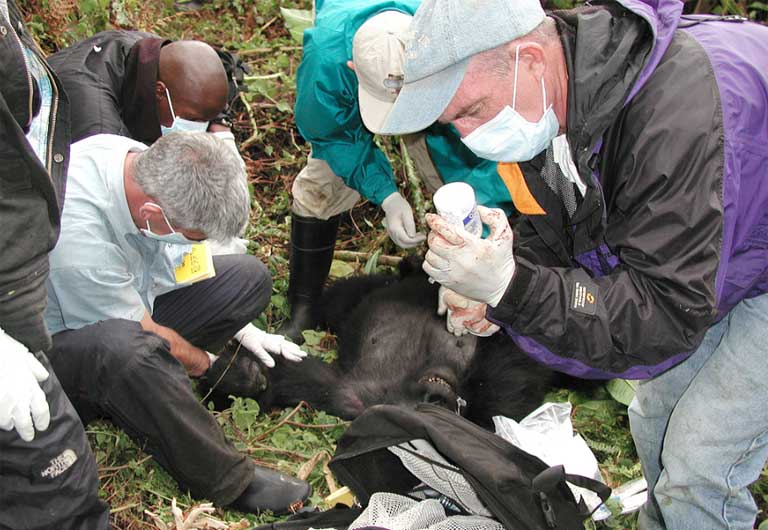
Over the last four decades, industrial agriculture has been a boon to Southeast Asia, but it also helped destroy more than 30 percent of Borneo’s rainforest — one of the last orangutan strongholds.
So when land-hungry, agro-industry investors recently began buying up forests in sub-Saharan Africa, great ape researchers knew that — although new oil palm plantations could bring prosperity to local people — they could also be catastrophic for gorillas, chimpanzees and bonobos.
Already, more than half of existing oil palm concessions in Africa overlap areas occupied by great apes, according to maps published in a Current Biology study. Another 40-plus percent of the lands within great ape habitats in the Congo Basin and West Africa have suitable soil for industrial agriculture.
The crush of new croplands against great ape habitat presents another, lesser known but no less ominous danger: infectious disease is now one of the three leading causes of great ape mortality. Some of those disease outbreaks are caused when human pathogens jump to great apes. Importantly, that leap can be a two-way street — the seeds of the human HIV/AIDS epidemic were sown in a long-ago leap of lentiviruses (viruses characterized by long incubation periods) from simians to people.
As the competition for land intensifies, more people end up moving into areas closer to where great apes live. That proximity poses significant health risks for these animals. Gorillas, for example, share people’s susceptibility to many diseases, yet are immunologically naive to them, and so lack our ability to fight them off — with possibly fatal consequences.
The potential for human infection with as yet unknown diseases carried by great apes is also very real.
Scientists are responding proactively to these threats. In the parklands of Rwanda, Uganda and the Democratic Republic of Congo (DRC), they are implementing conservation strategies that improve the health of mountain gorillas — and the health of people — successfully boosting great ape populations along with the well being of nearby human communities. This “one health” approach could benefit other impacted primate populations — such as lowland gorillas, chimpanzees and bonobos in West Africa — when industrial agriculture moves in.

Mountain gorillas on the brink
To the casual observer, it may seem that great apes protected inside Rwanda’s Volcanoes National Park, the DRC’s Virunga National Park, and Uganda’s Bwindi Impenetrable Forest and Mgahinga Gorilla National Park, are safe, and that nearby land grabs are irrelevant. But at the edges of the four African parks — where the world’s only remaining mountain gorillas live — are human communities with some of the densest rural populations on earth; upwards of 300 people crowd into every square kilometer.
With subsistence farming and small tea plantations bumping into park boundaries, it’s easy for the gorillas to raid community gardens and come into contact with the everyday refuse of human life. Inside the parks, locals travel the same trails used by gorillas, and tourists from all over the world come to visit, too. This mingling makes conditions ripe for the sharing of parasites, bacteria and viruses between people and great apes.
“We’ve always been a little nervous about the zoonotic potential [for diseases] because we have a small population of slowly reproducing animals in a park with a sharp border. And we’re surrounded by the highest density of people in all of Africa,” noted Mike Cranfield, a veterinarian who has worked with mountain gorillas in these three countries for almost two decades, first as director of the Mountain Gorilla Veterinary Project (MGVP) and now as co-director of Gorilla Doctors, a partnership between MGVP and the Wildlife Health Center at the University of California Davis.
Cranfield’s concern is justified. Respiratory disease outbreaks are on the upswing among gorillas, according to a twenty-year study. And, in 2009, tests for the first time directly linked mountain gorilla deaths from secondary bacterial pneumonia infection with human metapneumovirus. That’s a serious finding for the mountain gorillas since it can take years for the group to recover from the loss of even a single animal.
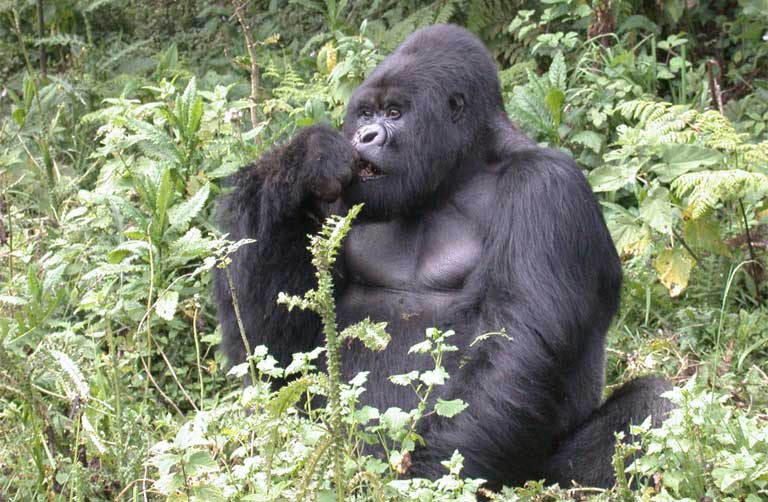
The good news is that these Critically Endangered mountain gorilla populations are growing. In the 1980s, the combined adverse impacts of civil war, poaching and forest encroachment dropped their numbers below 300. Now, the totals are almost three times that for the two existing mountain gorilla groups.
One of the two mountain gorilla populations is found on the Virunga Volcanoes Massif (which includes Rwanda’s Volcanoes National Park, DRC’s Virunga National Park, and Uganda’s Mgahinga National Park). This is the population that fell to an all-time low in the mid-1980s. Now it has risen from 240 to estimates of more than 500 individuals.
The second mountain gorilla group is found within the 128-square miles of Uganda’s Bwindi Impenetrable National Park. There was no baseline population data for this population, but there are more than 400 gorillas in Bwindi today.
One reason for the population rebound is the “extreme conservation” practiced by the Gorilla Doctors, an organization that trains animal health care teams to monitor almost 500 habituated mountain gorillas on a daily basis. (About half the mountain gorilla population has been deliberately acclimated to the presence of humans for tourism and research.)
Gorilla Doctors to the rescue
With regional headquarters in Rwanda, the Gorilla Doctors have seven facilities scattered across the three countries where they work.
The organization practices hands-on conservation methods, which means that nature isn’t always allowed to take its course. If a great ape has a “human induced” health problem that is life threatening, such as a snare injury or a respiratory illness that isn’t going away, then a veterinary team jumps in with surgical or medical “interventions,” said Cranfield. But treatment for naturallyoccurring traumas, such as bite wounds from other gorillas, are decided on a case-by-case basis, he said. On average, about 18 interventions take place throughout a year.
Although mountain gorillas have suffered from respiratory disease outbreaks, affecting an estimated 24 percent of gorilla groups, other great apes in Africa have fared far worse. In one study, respiratory illness caused 48 percent of deaths attributed to infectious disease among the chimpanzees in Tanzania’s Gombe Stream National Park, where Jane Goodall made her groundbreaking chimp studies.

Another series of outbreaks in wild chimpanzees at a research site in Côte d’Ivoire were linked to common paramyxoviruses from people. In those chimps, more than two decades of mortality data suggested that these human-originating outbreaks could have been occurring for a long time, said Fabian Leendertz, a wildlife disease epidemiologist at the Robert Koch Institute in Berlin.
Leendertz and his research team developed a method for detecting respiratory viruses in feces, which allows the scientists to search for the underlying cause of chronic non-lethal outbreaks, too.
“The method can be applied to all the great apes,” he said. “It would be especially good to know if human respiratory infections are more common than we think in flagship species such as the mountain gorillas.” That proof, he said, could help convince others –– such as policymakers, agribusiness, local communities, and eco-tour leaders –– of the urgency of implementing “every hygiene method possible to prevent spreading.”
Humans at risk too
The recurrence in history of viruses that can jump from animals to humans — ranging from simian immunodeficiency virus to Ebola virus — is ever present in these researchers’ minds. They know that gorillas, like chimps, could also harbor viruses that could spread to human populations.
Revealing such potential risks early is especially important now, as the oil palm industry sprawls across Africa and tourism booms, putting humans in closer quarters with populations of great apes.
The Gorilla Doctors are part of a global viral hunt, called PREDICT, to discover these potential pathogens before they cause human pandemics. The project was launched in 2009 with funding from USAID, the U.S. Agency for International Development. Research teams for PREDICT have travelled to more then thirty countries to test saliva and feces samples from bats, rodents and non-human primates — species known to have been part of previous spillover events. Whenever one of the mountain gorillas is anesthetized for any reason, the Gorilla Doctor team takes samples for viral testing.

Although more than 800 new viruses were discovered in animals during the first five years of the project, the trick is figuring out which of them are most likely to jump to another species, said Jonna Mazet, the PREDICT leader and director of the One Health Institute at University of California Davis. Studies by her team showed that viruses which can infect multiple hosts are the most likely candidates for spillovers.
The surveillance and monitoring models used for the mountain gorillas can be used for other species, noted Cranfield. Already they’ve been keeping tabs on eastern lowland gorillas (also called Grauer’s gorillas), a species which was recently reported to have suffered a decline by more than three-quarters of its population, now estimated at about 3,800 gorillas. The research team has also written a five-year health plan to extend monitoring around the Albertine Rift, a chain of mountains in central Africa that spans parts of Uganda, the Democratic Republic of the Congo, Rwanda, Burundi and Tanzania. “We hope to apply our work to as broad an area as possible,” said Cranfield.
Implementing the “one health” approach
A key to tracking the spread of diseases from people to gorillas is making a determination of what kinds of human behaviors increase that risk. In a study that looked at human activity around the Bwindi Impenetrable National Park in Uganda, Cranfield and his team found that local communities present 83 percent of the infectious disease risk to gorillas, rather than park staff or gorilla-watching tourists.
“If you have healthy people living around the great ape habitat, then the risk of the transmission of disease is low,” said Leendertz. “It’s important to see the benefits [of health] for both sides — the animals and the people — especially in this context.”
Creating health benefits for mountain gorillas and local people is the mission of Conservation Through Public Health (CTPH), a Uganda-based nonprofit founded by veterinarian Gladys Kalema-Zikusoka.
Kalema-Zikusoka didn’t set out to become a defender of public health. But her work as a veterinarian for the Uganda Wildlife Authority drew her into a mountain gorilla disease investigation that brought home the impact of human health on great ape survival. Her interest was first piqued when she observed the Katendegyere gorilla troop, which once ranged in Bwindi National Park. The animals were suffering from a mysterious scaly, itchy skin affliction. One infant lost most of his hair, and became so weakened that he died. The disease? A scabies mite, commonly found in impoverished people.
At the time, it wasn’t possible to prove the parasite originated with humans. But Kalema-Zikusoka hypothesized that crop-raiding forays likely exposed the gorillas –– perhaps to a scarecrow dressed in human clothes which carried the mites. Losing such a young ape to a skin parasite was a turning point: she realized that keeping people healthy would also keep gorillas healthy. So Kalema-Zikusoka quit her government job to begin saving gorillas from human illnesses — taking a public health approach to the problem.
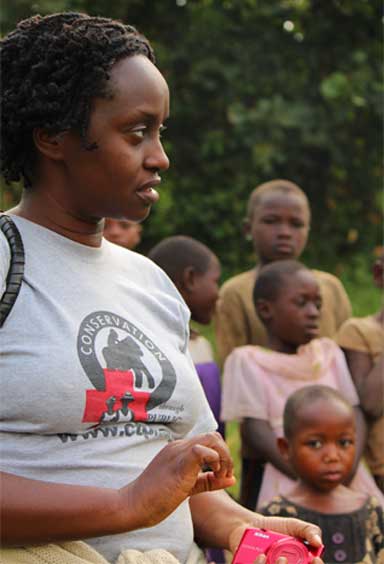
The specter of shared diseases — afflicting both people and great apes — enabled her to gain funding for human health programs, and then integrate gorilla conservation into her efforts. She started by setting up tuberculosis monitoring programs around southwestern Uganda where she is based. If gorillas ever get TB from people, it would be a total disaster, she said. In people, such a disease requires months of treatment. “After a few days of medication, there’s no way a gorilla would let you anywhere near them, so that would be the end of that,” she said.
Intestinal parasites and diarrhetic diseases can also be a serious problem for mountain gorillas living near people, explained Kalema-Zikusoka. “Like human babies, the young gorillas are very curious and they’ll put anything in their mouths,” she said. Studies have shown that gorillas in proximity to human communities have higher rates of intestinal parasites similar to those found in the local people. More alarming, perhaps, some gorillas even harbor antibiotic-resistant bacteria of the type found in humans. At the CTPH gorilla health center, fecal samples from gorillas, livestock and people are now getting regularly analyzed to monitor for shared parasites and bacteria.
Among the biggest successes of CTPH, are its village health and conservation teams. Each volunteer visits 50-100 households per village to educate people about family planning, hygiene, sanitation and gorilla conservation. As a result, said Kalema-Zikusoka, there’s been a 50 percent increase in hand washing facilities (up from about 10 percent), and more than 60 percent of communities reached by CTPH now have latrines. All these improvements have led to fewer transfers of disease between people and gorillas. The outreach effort creates greater tolerance for gorillas, too, which helps reduce human-great ape conflict.
Kalema-Zikusoka plans to expand the reach of CTPH to all the parishes surrounding the Bwindi Forest, places where there are community conflicts with gorillas. Ultimately, she’d like to implement similar programs where other gorillas are found, including Cameroon — whose forests are targeted for large-scale oil palm production.
The work of these pioneering “one health” practitioners is being shared in other ways. The IUCN just published a guide for those working with great apes, which included contributions from Kalema-Zikusoka, Leendertz, and Cranfield. Among the book’s targeted audience are gorilla-trek operators, guides and trackers who regularly work with tourists — both a boon and bane to great apes. The influx of tourists brings in “eco-dollars” (which fund conservation and fuel local economies), but also exposes great apes to travelers who may carry pathogens from far-flung parts of the globe.
Although everyone is told to stay at least seven meters away from gorillas, that can be a hard dictum to follow for eager tourists peering through dense vegetation, and for sometimes equally curious gorillas. Protective masks, like those worn in doctors’ offices during flu season, are now only mandatory for tourists in the DRC’s Virunga National Park. But if implemented elsewhere, they could offer a simple barrier to sharing respiratory infections.
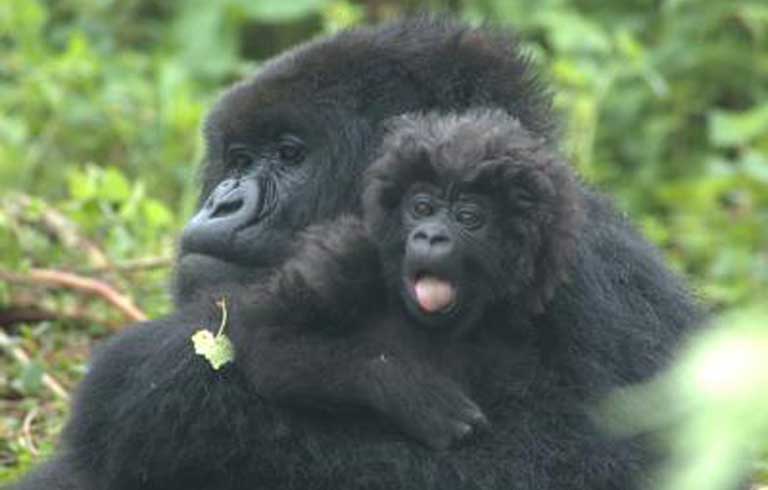
Maximizing the conservation benefits of tourism and mitigating potential negative impacts is one focus of the International Gorilla Conservation Programme (IGCP), a coalition of Fauna & Flora International and the World Wildlife Fund for Nature. IGCP tries to foster collaboration among government agencies, NGOs and other nonprofit groups, to leverage conservation efforts and resources, said Anna Behm Masozera, the IGCP director. “It’s a constant pursuit of best practices,” she said, “based on a combination of the most up-to-date scientific information and on-the-ground realities.”
A prescription for great ape conservation and human health
By this time next year, conservationists will know whether their efforts have helped prevent disease and raised the population of mountain gorillas in the Virunga Massif since the last survey, conducted in 2010.
The massive logistical effort of surveying an area that spans three countries and covers treacherously steep volcanic slopes and mountain ravines is being led by the Greater Virunga Transboundary Collaboration and is supported by ten institutions, including the IGCP.
Beyond the actual head count, there’s value “in getting boots on the ground,” observed IGCP’s Behm Masozera. The survey teams collect gorilla fecal samples for genetic analyses and take note of nesting sites. They also record encounters with other mammals, such as elephants, and destroy the illegal snares that can be hazards for all wildlife.
“We are hopeful that the results of the ongoing survey will show that this population of mountain gorillas is still growing, but we know that one disease outbreak could undo decades of success,” said Behm Masozera. “We also know that what we have learned, and what we continue to pursue as best practice in our densely human populated region, can inform how to help other great ape populations and human communities.”
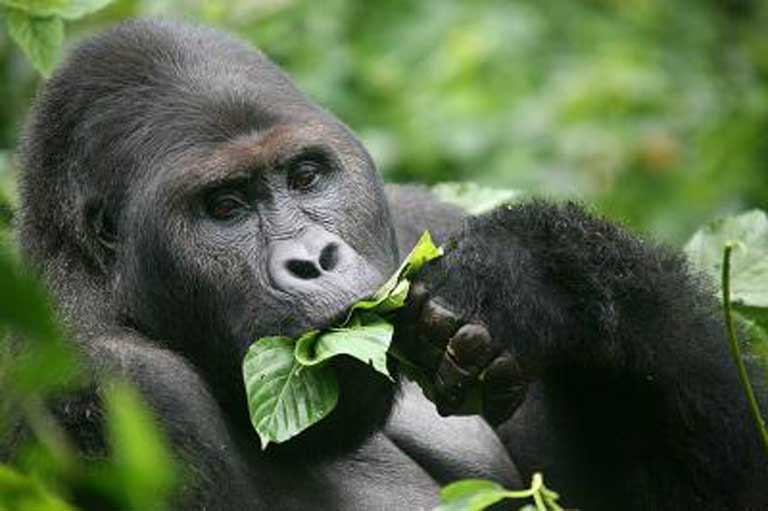
Citations:
Arcus Foundation (2014) State Of The Apes: Extractive Industries and Ape Conservation. Cambridge University Press.
Calvignac-Spencer S, et al. (2012) Wild great apes as sentinels and sources of infectious disease. Clinical Microbiology and Infection. Vol.18, p.521.
Gilardi KV, et al. (2015) Best Practice Guidelines for Health Monitoring and Disease Control in Great Ape Populations. Gland, Switzerland: IUCN SSC Primate Specialist Group.
Graczyk TK, et al. (2001) Hyperkeratotic mange caused by Sarcoptes scabei (Acariformes: Sarcoptidae) in juvenile human-habituated mountain gorillas (Gorilla gorilla beringei). Parasitology Research. Vol. 87, p.1024.
Kalema-Zikusoka G, et al. (2002) Scabies in free-ranging mountain gorillas (Gorilla beringei beringei) in Bwindi Impenetrable National Park, Uganda. Veterinary Record, Vol.150, p.12.
Kondgen S, et al. (2008) Pandemic human viruses cause decline of endangered great apes. Current Biology. Vol.18, p. 260.
Leendertz FH, et al. (2006). Pathogens as drivers of population declines: the importance of systematic monitoring in great apes and other threatened mammals. Biological Conservation. Vol.131, p.325.
Linder J. (2013) African primate diversity threatened by new wave of industrial oil palm expansion. African Primates. Vol. 8 p25.
Maldonado O, et al. (2012) Grauer’s Gorillas and Chimpanzees in Eastern Democratic Republic of Congo (Kahuzi-Biega, Maiko, Tayna and Itombwe Landscape) Conservation Action Plan 2012-2022. International Union for Conservation of Nature and Natural Resources. IUCN, Gland, Switzerland
Nizeyi JB. (2012) Risk assessment of human behaviours that may impact on the health of the Mountain Gorillas around Bwindi Impenetrable National Park, Western Uganda Africa. Journal of Animal and Biomedical Sciences. Vol. 7, p 102.
Palacios G, et al. (2011) Human metapneumovirus infection in wild mountain gorillas, Rwanda. Emerging Infectious Diseases. Vol. 17, p 711.
Ryan S and Walsh P. (2011) Consequences of Non-Intervention for Infectious Disease in African Great Apes. PLOS One. Vol. 6.
Rwego IB, et al. (2008) Gastrointestinal bacterial transmission among humans, mountain gorillas, and livestock in Bwindi Impenetrable National Park, Uganda. Conservation Biology. Vol. 22. p.1600.
Spellman LH, et al. (2013) Respiratory disease in mountain gorillas (Gorilla beringei beringei) in Rwanda, 1990–2010: Outbreaks, clinical course, and medical management. Journal of Zoo and Wildlife Medicine. Vol. 44, p.1027.
Twongyirwe R. (2011) Dynamics of forest cover conversion in and around Bwindi impenetrable forest, Southwestern Uganda. J. Appl. Sci. Environ. Manage. Vol. 15, p189.
Wich SA, et al. (2014) Will Oil Palm’s Homecoming Spell Doom for Africa’s Great Apes? Current Biology. Vol. 24, p1659-1663
